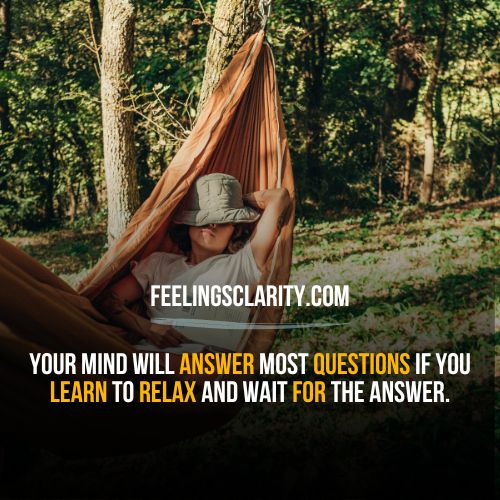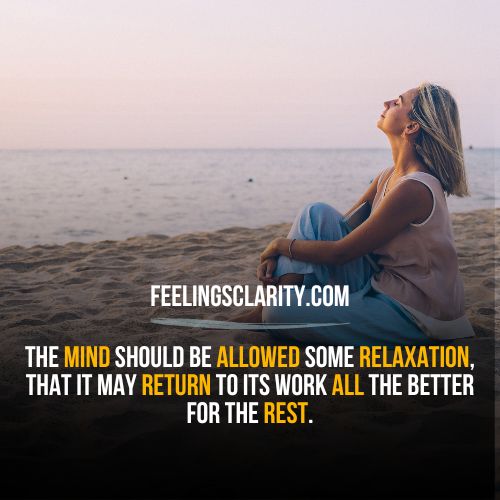In the relentless hustle and bustle of today’s fast-paced world, the need for relaxation has become more crucial than ever. As demands on our time, energy, and attention continue to escalate, finding moments of tranquility has evolved from a luxury to a necessity.
The ability to unwind and de-stress not only enhances our mental and emotional well-being but also has a profound impact on our physical health.
In recognizing this need, let us embark on a journey to delve into the techniques to relax yourself – uncovering practical, effective, and immediate techniques that can usher in a sense of calm amidst the chaos.
In this blog post, our aim is to equip you with a toolkit of invaluable methods that can swiftly whisk you away from the grip of stress and tension. We understand that life often leaves us with limited time to spare, which is why our focus is on providing you with techniques that can be seamlessly integrated into your daily routine.
Whether you’re facing a nerve-wracking deadline, caught up in the demands of family and work, or simply seeking solace from the never-ending digital deluge, these tips are designed to offer respite in the blink of an eye.
As we traverse through the following sections, you’ll discover the power of deep breathing and mindful awareness – a gateway to centering yourself amidst the chaos. We’ll delve into the concept of progressive muscle relaxation, a technique that can unknot the physical manifestations of stress.
Visualization and guided imagery will whisk you away to tranquil mental landscapes, while quick mindfulness meditation will ground you in the present moment. And for those seeking a sensory escape, we’ll explore the wonders of engaging your senses and the soothing embrace of aromatherapy.
So, whether you’re a seasoned relaxation seeker or someone taking the first step towards a more serene existence, these techniques are tailor-made to suit every lifestyle and schedule.
The frenetic pace of life may not be something we can control, but our response to it is well within our grasp. Let’s embark on this journey together, as we unlock the secrets of instant relaxation and pave the way for a more balanced, rejuvenated, and tranquil you.
Here are some of the techniques to relax yourself immediately.

Jump to a Specific Section
- 1 Deep Breathing and Mindful Awareness
- 2 Progressive Muscle Relaxation
- 2.1 1. Defining Progressive Muscle Relaxation:
- 2.2 2. Step-by-Step Instructions for Progressive Muscle Relaxation:
- 2.3 3. Focusing on Each Muscle Group for Relaxation:
- 2.4 4. Positive Impact of Regular Practice:
- 2.5 Stress Reduction:
- 2.6 Improved Sleep:
- 2.7 Enhanced Body Awareness:
- 2.8 Mind-Body Harmony:
- 2.9 Reduced Muscle Pain:
- 3 Visualization and Guided Imagery
- 4 Quick Mindfulness Meditation
- 5 Sensory Engagement and Aromatherapy
- 5.1 1. The Role of the Senses in Relaxation:
- 5.2 2. Activities to Engage Your Senses:
- 5.3 Auditory Delight:
- 5.4 Tactile Comfort:
- 5.5 Taste Sensations:
- 5.6 Visual Escape:
- 5.7 2. Aromatherapy and Its Mood-Enhancing Impact:
- 5.8 3. Popular Calming Essential Oils and Usage Methods:
- 5.9 Lavender:
- 5.10 Chamomile:
- 5.11 Frankincense:
- 5.12 Bergamot:
- 5.13 4. Methods of Use:
- 6 Conclusion:
- 7 Frequently Asked Questions (FAQs):
Deep Breathing and Mindful Awareness
In the whirlwind of our modern lives, it’s easy to forget the profound impact that something as simple as our breath can have on our overall well-being.
Deep breathing, often referred to as diaphragmatic breathing or belly breathing, is a powerful tool that can swiftly guide us from a state of tension to one of tranquility.
The connection between deep breathing and relaxation lies in its ability to activate the body’s parasympathetic nervous system, also known as the “rest and digest” response. This physiological shift counters the “fight or flight” response triggered by stress, leading to reduced heart rate, lowered blood pressure, and a sense of calm.
1. A Simple Deep Breathing Exercise:
- Find a comfortable seated or lying position.
- Place one hand on your chest and the other on your abdomen.
- Inhale deeply through your nose, letting your abdomen rise as you fill your lungs.
- Exhale slowly through your mouth, feeling your abdomen fall as you release the breath.
- Focus your attention solely on your breath, letting go of other thoughts.
2. Mindful Awareness for Staying Present and Calm:
As you embark on this journey of deep breathing, consider incorporating mindful awareness. Mindfulness involves paying deliberate, non-judgmental attention to the present moment. As you breathe deeply, direct your focus entirely onto each inhale and exhale.
If your mind starts to wander (as it often does), gently guide your attention back to the sensation of your breath. By doing so, you’re cultivating a mental state that promotes clarity, reduces anxiety, and enhances overall well-being.
3. Benefits of Deep Breathing and Mindfulness:
Stress Reduction:
Deep breathing triggers the relaxation response, reducing the levels of stress hormones like cortisol. This can lead to an immediate sense of calm and improved emotional regulation.
Increased Focus:
Practicing mindfulness strengthens your ability to concentrate, as you learn to direct your attention to the task at hand.
Emotional Resilience:
Deep breathing and mindfulness help you respond to challenging situations with greater equanimity, reducing the intensity of emotional reactions.
Physical Benefits:
Lowered blood pressure, improved digestion, and reduced muscle tension are among the physical rewards of these practices.
Better Sleep:
Incorporating deep breathing and mindfulness into your bedtime routine can help quiet a racing mind, paving the way for restful sleep.
Incorporating deep breathing and mindfulness into your daily routine doesn’t require a significant time investment.
Whether you choose to set aside a few minutes in the morning, during your lunch break, or before bed, these practices can become touchstones of tranquility amid the chaos. By dedicating yourself to these techniques, you’re gifting yourself moments of self-care, resilience, and a pathway to immediate relaxation.
Progressive Muscle Relaxation
In the midst of our fast-paced lives, our bodies often bear the brunt of stress and tension, resulting in physical discomfort and fatigue.
Progressive Muscle Relaxation (PMR) is a technique designed to counteract this strain by systematically releasing muscle tension and promoting a deep sense of relaxation. Rooted in the understanding that the body and mind are intricately connected, PMR offers a holistic approach to unwinding and finding respite from the demands of daily life.
1. Defining Progressive Muscle Relaxation:
Progressive Muscle Relaxation is a method developed to bring about relaxation by consciously tensing and then releasing specific muscle groups. By doing so, you heighten your awareness of bodily sensations and gradually train your body to let go of accumulated tension.
2. Step-by-Step Instructions for Progressive Muscle Relaxation:
1) Sit or lie down in a quiet, comfortable space. Loosen any tight clothing and remove distractions.
2) Take a few deep breaths to calm your mind and set the tone for relaxation.
3) Start at your feet and work your way up. For each muscle group, follow these steps:
4)Tighten the muscles in the specific group as much as you comfortably can without straining.
5) Maintain this tension for about 5-10 seconds, focusing solely on the sensations.
6) Suddenly let go of the tension, allowing the muscles to relax completely.
7) Move through your body, targeting major muscle groups: feet and toes, calves, thighs, abdomen, chest, back, hands, arms, shoulders, neck, and face.
8) As you tense and release each muscle group, pay close attention to the contrast between tension and relaxation.
9) Continue to breathe deeply and rhythmically throughout the practice.
10) Once you’ve completed the sequence, take a few minutes to lie still and bask in the newfound relaxation.
3. Focusing on Each Muscle Group for Relaxation:
The effectiveness of Progressive Muscle Relaxation lies in the deliberate attention you give to each muscle group. This technique encourages you to experience the contrast between tension and relaxation, making it easier to discern when and where you’re holding tension in your body.
By becoming attuned to these sensations, you can actively work to release physical stress and restore balance.
4. Positive Impact of Regular Practice:
Stress Reduction:
Regular practice of PMR can significantly reduce stress levels and mitigate the negative effects of chronic stress on both body and mind.
Improved Sleep:
Relaxing the body can pave the way for more restful sleep, as the physical tension that often disrupts sleep is gradually released.
Enhanced Body Awareness:
By focusing on individual muscle groups, you become more in tune with your body, allowing you to address tension more effectively.
Mind-Body Harmony:
Progressive Muscle Relaxation reinforces the interconnectedness of mind and body, fostering a sense of overall well-being.
Reduced Muscle Pain:
For those prone to muscle tension and discomfort, PMR can alleviate physical pain and promote healing.
Incorporating Progressive Muscle Relaxation into your routine need not be time-consuming; even dedicating a mere 10-15 minutes can yield significant benefits. By engaging in this practice regularly, you’re not only prioritizing your physical health but also nurturing a deeper connection between your body and mind – a harmonious relationship that supports your journey toward relaxation and holistic wellness.
Visualization and Guided Imagery
Amidst the chaos of modern life, finding moments of respite and tranquility can be a challenge. Enter the world of visualization and guided imagery – a realm where the power of the mind transports us to serene landscapes and peaceful retreats.
This technique allows us to tap into the incredible capacity of our imagination to create mental images that can offer solace, relaxation, and a much-needed break from the daily grind.
1. The Concept of Visualization and Guided Imagery:
At its core, visualization and guided imagery involve conjuring vivid mental images that evoke sensations, emotions, and a sense of presence. By engaging the mind’s eye, you can transport yourself to places both real and imagined, harnessing the therapeutic benefits of these mental excursions.
2. Creating Mental Images to Transport the Mind:
The mind is a potent tool, capable of conjuring scenes that elicit emotions and reactions as real as those experienced in the physical world. By immersing yourself in a mental image, you can trigger a cascade of relaxation responses within your body.
Whether it’s the rhythmic sound of ocean waves, the warmth of the sun’s rays, or the gentle rustling of leaves, your mind has the capacity to make these sensations palpable.
3. Examples of Scenarios to Visualize:
Tranquil Beach:
Imagine yourself on a secluded beach with powdery sand and crystal-clear waters. Feel the gentle breeze against your skin and listen to the rhythmic sound of waves.

Serene Forest:
Visualize walking through a serene forest, surrounded by tall trees and dappled sunlight. Inhale the crisp, refreshing air and listen to the peaceful sounds of birds and rustling leaves.
Mountaintop Retreat:
Transport yourself to a mountaintop with panoramic views. Feel the cool mountain air and bask in the awe-inspiring landscape stretching out before you.

Quick Mindfulness Meditation
In the whirlwind of our daily lives, where distractions and demands pull us in every direction, finding a way to ground ourselves in the present moment can be transformative.
Mindfulness meditation, a practice rooted in ancient traditions, offers a pathway to cultivating awareness, presence, and inner peace. Its simplicity and accessibility make it an ideal technique for both meditation novices and experienced practitioners seeking a quick respite from the chaos.
1. Grounding Oneself in the Present Moment:
Mindfulness meditation involves focusing your attention on the present moment – on your thoughts, feelings, bodily sensations, and surroundings – without judgment. By doing so, you detach from the past and future, allowing you to fully engage with your current experience.
This practice fosters a heightened sense of clarity, emotional balance, and a deep connection to your surroundings.
2. A Brief Mindfulness Meditation Technique:
Find a Quiet Space:
Choose a quiet spot where you won’t be disturbed for a few minutes. Sit comfortably with your back straight and hands resting on your lap.
Focus on Your Breath:
Close your eyes and take a few deep, intentional breaths. Then, let your breath settle into its natural rhythm. Observe each inhale and exhale without trying to control it.
Body Scan:
Slowly direct your attention to your body. Starting from the top of your head, gently scan down through your body, noting any sensations without judgment. Release any tension you may notice.
Observe Your Thoughts:
As thoughts arise – and they will – acknowledge them without attaching to them. Imagine each thought as a passing cloud in the sky of your mind.
Return to the Breath:
Whenever your mind drifts away, gently guide your attention back to your breath. Use it as an anchor to the present moment.
Expand Awareness:
Gradually expand your awareness to encompass sounds, sensations, and the environment around you. Continue to maintain a non-judgmental observation.
Closing:
After a few minutes, open your eyes and take a moment to reorient yourself to your surroundings. Notice how you feel compared to when you started.
Sensory Engagement and Aromatherapy
In our modern world, where the demands of daily life often pull us in countless directions, finding solace and relief from stress is paramount.
Our senses, those remarkable gateways to experience, offer us a powerful avenue to tap into relaxation. Engaging your senses intentionally can create a harmonious connection between body and mind, fostering moments of respite and calm.
One particularly effective way to achieve this is through sensory engagement and the age-old practice of aromatherapy.
1. The Role of the Senses in Relaxation:
Our senses are our windows to the world, translating external stimuli into rich experiences. Harnessing the power of these senses can be a deliberate act of self-care. Engaging your senses helps shift your focus away from the whirlwind of thoughts and immerse yourself in the present moment, inviting tranquility and serenity.
2. Activities to Engage Your Senses:
Auditory Delight:
Listen to calming music, nature sounds, or soothing podcasts to create an auditory oasis that fosters relaxation.
Tactile Comfort:
Touch soft fabrics, stress balls, or textured objects to ground yourself and release physical tension.
Taste Sensations:
Savor a comforting cup of herbal tea, a piece of dark chocolate, or any favorite treat that brings joy to your taste buds.
Visual Escape:
Immerse yourself in artwork, a scenic nature view, or even photographs that evoke positive emotions.
2. Aromatherapy and Its Mood-Enhancing Impact:
Aromatherapy, an ancient practice, harnesses the power of scents to influence our emotions, mood, and overall well-being. Essential oils, extracted from various plants, are potent tools in this practice.
These oils have the ability to trigger physiological and psychological responses when inhaled or applied to the skin, making them an excellent aid for relaxation.
3. Popular Calming Essential Oils and Usage Methods:
Lavender:
Renowned for its soothing properties, lavender oil promotes relaxation and eases stress. Diffuse it in your space or add a few drops to a warm bath.
Chamomile:
Chamomile oil is excellent for calming nerves and promoting sleep. Use it in a diffuser or blend it with a carrier oil for a calming massage.
Frankincense:
Known for its grounding and centering effects, frankincense can be diffused during meditation or applied topically for a soothing massage.
Bergamot:
Bergamot oil is uplifting and can help alleviate anxiety. Add a few drops to a room diffuser or blend with a carrier oil for a stress-relief massage.
4. Methods of Use:
- Diffusers: Use an essential oil diffuser to disperse the scent throughout your space, creating an aromatic atmosphere.
- Rollerballs: Dilute essential oils with a carrier oil and apply using rollerballs on pulse points for on-the-go relaxation.
- Baths: Add a few drops of essential oil to a warm bath for a calming soak.
- Inhalation: Place a drop or two on a tissue and inhale deeply for an instant sense of relaxation.
By consciously engaging your senses and incorporating aromatherapy into your routine, you’re inviting a symphony of relaxation into your life. These practices offer you simple, tangible ways to escape the stress of daily life, even if just for a brief moment.
They’re reminders that nurturing yourself through sensory experiences is not only a self-indulgent act but a vital component of maintaining your well-being and reclaiming a sense of inner peace.
Conclusion:
In a world that seems to move at an ever-increasing pace, the quest for immediate relaxation is a journey worth embarking upon. The tips and techniques explored in this blog post offer a repertoire of tools that can transform fleeting moments of stress into windows of serenity.
By embracing deep breathing and mindful awareness, you can anchor yourself in the present, finding refuge in the gentle rhythm of your breath. Progressive muscle relaxation becomes your ally, untangling the knots of tension that accumulate in your body, while visualization and guided imagery open portals to tranquil landscapes of your own creation.
Mindfulness meditation, a simple yet profound practice, equips you with the ability to find stillness in the midst of chaos. Sensory engagement and aromatherapy invite you to explore the treasures of your senses, enabling you to immerse yourself in the present and rediscover the beauty of the world around you.
Remember, these techniques are not distant goals but immediate allies. In just a matter of minutes, you can summon calm, cultivate clarity, and restore balance.
By weaving these practices into the fabric of your daily routine, you’re crafting a sanctuary of relaxation within yourself – a sanctuary that you can access whenever the demands of life become overwhelming.
So, as you navigate the currents of life’s challenges, make a conscious choice to pause, breathe, and engage with these techniques. In doing so, you’re reclaiming moments of peace, nurturing your well-being, and tending to the garden of your inner tranquility. Ultimately, the power to relax immediately lies within your grasp; all it takes is the willingness to take that first step towards a more centered and serene you.

Frequently Asked Questions (FAQs):
What is the best time to practice these relaxation techniques?
The best time varies for each individual. Experiment with different times of the day to find what works best for you. Many find that practicing in the morning sets a positive tone for the day, while others prefer unwinding with these techniques in the evening.
Can these techniques help with chronic stress or anxiety?
Yes, these techniques are often recommended as effective strategies for managing chronic stress and anxiety. Regular practice can help reduce the intensity of these emotions and provide coping mechanisms.
How long should I practice these techniques to see results?
Even a short practice can yield immediate benefits. Starting with just a few minutes a day is a great way to begin. Over time, you can gradually extend your practice to reap more substantial and lasting rewards.
Is there a right or wrong way to practice these techniques?
The beauty of these techniques lies in their flexibility. There’s no “right” or “wrong” way – it’s about finding what resonates with you. Adapt and modify the techniques to suit your preferences and needs.
Can I combine these techniques?
Absolutely! Combining techniques can create a comprehensive relaxation routine. For instance, you can start with deep breathing, move into progressive muscle relaxation, engage in visualization, and then conclude with a few minutes of mindfulness meditation.
How can I incorporate these techniques into a busy schedule?
Many of these techniques can be practiced in just a few minutes. You can integrate them into your day during short breaks, waiting times, or before bed. Remember, even brief moments of relaxation can make a significant impact.
Are there any age restrictions for practicing these techniques?
These techniques are generally suitable for people of all ages. However, it’s advisable to adjust instructions and guidance to suit the capabilities of children and individuals with specific medical conditions.
Are there any risks associated with these practices?
These relaxation techniques are generally safe. However, if you have certain medical conditions, it’s a good idea to consult a healthcare professional before making them a regular part of your routine.
Can these techniques replace professional therapy or medical treatment?
While these techniques can be incredibly beneficial for managing stress and promoting relaxation, they’re not substitutes for professional therapy or medical treatment when necessary. If you have severe anxiety, depression, or other medical concerns, seek guidance from a healthcare professional.
How can I stay motivated to practice these techniques consistently?
Setting a regular schedule, keeping a journal of your experiences, and involving a friend or family member can help maintain motivation. Remember that consistent practice leads to more profound and lasting benefits.